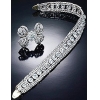 When Jean Cocteau was shooting Beauty and the Beast
in 1946 starring Jean Marais, the latter offered to produce diamond replica for
the episode of the palace dancing. Cocteau
rejected the idea saying that fake diamonds would not glow. However, fifty
years later, we have fake diamonds manufactured so subtly that it is sometimes hard
enough to sort them out. So,
how to sort the diamonds from other gems, including fake one? When Jean Cocteau was shooting Beauty and the Beast
in 1946 starring Jean Marais, the latter offered to produce diamond replica for
the episode of the palace dancing. Cocteau
rejected the idea saying that fake diamonds would not glow. However, fifty
years later, we have fake diamonds manufactured so subtly that it is sometimes hard
enough to sort them out. So,
how to sort the diamonds from other gems, including fake one?
Fraud
or imitation?
Today the gems including synthetic ones looking similar
the diamonds are applied in many life spheres for their look. Such gems are called
diamond simulants but not falsified diamonds since the manufacturer and sellers
are obliged to provide full information on the jewelry origin and its quality. Yet, such jewelry
items cost far cheaper than true stones. Natural stones or gems are used to
manufacture diamond simulants like zirconium silicate, white sapphire, topaz, rock
crystal or synthetic gems as mussanit, titanite, stabilized zircon, lithium
niobate and others).
Moreover,
synthetic stones appear far more perfect and pure than natural stones and they
differ in only the origin. Thus, diamond stimulants
based jewelry is not fraud. Nevertheless, it so difficult to confuse in purity
and authenticity of stones sometimes abused by malicious manufacturers. There are some more
ways to sort our authentic and synthetic diamonds, though.
Laboratory
testing
As anything of quality, the diamond should be certified
to conform to requirements, so the stone should have papers to describe its
physical qualities and characteristics. Such certificates are issued by companies
which are few of them in the world and the most influential of them is the Gemological
Institute of America.
Any
stone should be examined and evaluated by qualified experts to specify its
authenticity and purity. The specialists study
the optical refraction of the stone since diamond faceting is done in the way
when the light is refracted off the back face as in the mirror. The experts also
use hydrochloric acid that to apply onto the diamond stone to check whether it
leaves spots on synthetic stones while true diamonds stay intact.
On the top of it, special tools are used to define the
stone authenticity. Such devices alow controlling and recording heat conductivity,
UV light relative permeability, absorption spectrum and other parameters. Most
of such devices are not affordable to anyone to spend leisure time checking
diamonds and diamond stimulant and thus, as the case may be, the stone should
be verified for authenticity by experts.
Home testing
The identity of diamonds can be established personally
by simple actions, though. First, the way the diamonds are manufactured
and
offered for sale. Synthetic minerals are inserted into closed settings
when part
of the stone is hidden. Authentic
diamonds are inserted into open settings only. Another option to
identify
authenticity is using plain finishing paper which is safe for true
diamonds. However, today there are so many materials marketed to
resist to attrition and mechanical damage as the authentic diamonds do.
Another
test to verify authenticity of the stone is permeability of heat. A natural stone keeps cold at any ambient temperature,
though it gets warmer if kept in hands for a few minutes. The thermal capacity of
diamonds vs. stimulants can be also checked by blowing the breath onto the
stone and leaving no condensate onto it. When examining authenticity of diamonds
at home, the 30x power magnifying glass will help to identify natural inclusions
that appear with most natural diamonds whereas synthetic diamonds are always
pure.
The authenticity of natural diamonds can be checked by
examining the refraction of light of the stone turning it with the crown
to the
light source to see a white dot inside. This approach is good for stones
with
classic fifty seven facets. UV-light is another option to verify
diamonds. Diamonds glow differently in the UV light while diamond
stimulants are recognized for the similar glowing of every single stone.
|